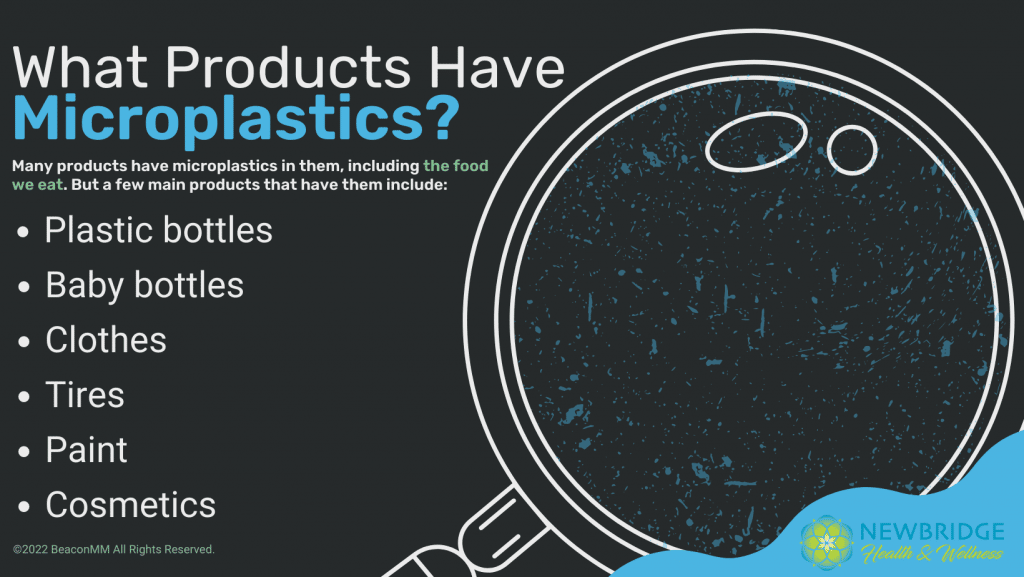Humans have become increasingly reliant on synthetic materials, and because of how they are derived, and that they are made to last, these materials remain in the environment. Durability is great, but it’s really hard for these materials to break down, meaning they have infiltrated almost every area of our lives and our ecosystems.
As the world has become increasingly reliant on plastic, microplastics in particular are incredibly hard to avoid. From food, water, cosmetics, and the air, studies show that plastic is almost everywhere. In this blog we’ll explain why this is hazardous and what you can to do limit your exposure.
Are you interested in functional medicine? Learn more about how functional medicine practices like Newbridge Health and Wellness can help get to the root cause of your health issues!
What Are Microplastics?

Plastic is used in all kinds of everyday products such as food packaging, clothing, carpeting, personal care products, appliances, cars, and electronics. It was first developed in the 1950s and continues to be widely used today. There’s no doubt it’s made a lot of things more convenient, but it can also be hazardous to our health.
Researchers are finding microplastics, which are pieces of plastic smaller than 5 millimeters, in food, soil, water, and even the air we breathe. Although they can vary in size and makeup, they can contain various polymers and additives such as flame retardants, stabilizers, and colorants. The negative impact of microplastics first came to light when they were found in marine habitats across the globe. However, as awareness has increased, people are finding them everywhere.
Some products that microplastics most commonly come from include:
- Plastic bottles
- Baby bottles
- Clothes
- Tires
- Paint
- Cosmetics
Single-use plastics continue to be widely used, which means more microplastics are entering our ecosystem all the time. In other words, it’s time to take action to protect yourself from these tiny contaminants.
Why are Microplastics Hazardous to Consume?
Since microplastics are so tiny, they are often undetectable, and can easily be ingested through food, water, and the air. Some researchers estimate that people ingest between 39,000 to 52,000 particles annually.
The exact implications of our exposure to microplastics are unknown as it is a recent issue. However, dangerous chemical substances in them pose potential health concerns. For example, since microplastics can be easily ingested or inhaled, it’s reasonable to assume that microplastics could damage cells or induce inflammatory and immune reactions.
As microplastics take up increasing amounts of space in the oceans and on land, it inevitably has an ecological consequence. Once microplastics enter the environment, they can be consumed by animals and then transferred to humans. One of the easiest ways to ingest microplastics is by eating seafood since there are many microplastics in the ocean.
We need more research to fully understand the impact that microplastics will have on our bodies. However, as there is evidence that they contain toxic chemicals, it’s best to avoid them as much as possible.
How to Limit Your Exposure to Microplastics
Although microplastics can be found in almost everything, there are still some ways to avoid them. It begins with identifying where microplastics are most likely to be, such as plastic bags, straws, fishing nets, or cosmetics. Here are some ways you can reduce the amount of microplastics in your food.
Avoid Plastic Bottles
Drinking bottled waters or sodas is a common way to ingest microplastics. People who drink from bottled waters can consume 90,000 plastic particles annually compared to only 4,000 from tap water.
People can turn to alternatives such as using a water filter for their water consumption. Bottled water is not subject to the same testing and requirements as most tap water, so the quality can often be unknown.
Don’t Heat Food in Plastic
Avoiding heating food in plastic containers can also mitigate your exposure. Heat can change the chemical properties of the plastic, allowing particles to seep into your food– that’s especially true for takeout. The heat from the food can affect the plastic and make you more susceptible to ingesting microplastics. Heating your food on something made from a different material can greatly reduce your chances of ingesting microplastics.
Are you interested in improving your health? Contact Newbridge Health and Wellness to take your health to the next level!
Steer Clear of Certain Types of Seafood
Let’s dive into the issue of seafood. As we know, increased microplastics in the oceans are affecting the quality of what we catch and eat. This can make it easy for us to ingest microplastics, so swapping fish for other fresh foods can boost your overall health while reducing the chance of microplastics entering your system. You should also be wary while eating any of the following:
- Small fish
- Clams
- Oysters
- Muscles
- Scallops
Reducing your consumption of these types of seafood can reduce your exposure.
Use Functional Nutrition to Drive Your Health
Dietary changes through the principles of integrative and functional nutrition can greatly benefit individuals. For example, some foods work to fuel our bodies better than others, so integrative and functional nutrition focuses on finding options that best suit a persona’s natural biochemistry. According to the core principles of functional medicine, your body systems are interconnected, and your genetics, biochemistry, gut microbiome, age, gender, and lifestyle choices impact how health happens and progresses, or whether disease is triggered.
Diet provides the essential foods and nutrients for health and growth, because what we eat is used for energy and information. Our food can be contaminated with added chemicals, dyes, preservatives, and microplastics that can hurt our bodies.
Integrative and functional nutrition differs from other approaches as it emphasizes treating the whole person. It empowers a person to change their diet to heal, and taking other measures to pinpoint root causes of health problems, which often include poor diet.
If you’re interested in implementing functional nutrition into your life, you can talk with our functional nutritionist to create a personalized plan that fits your lifestyle and accounts for foods you like and dislike. Nutrition plans typically include:
- Therapeutic meal plans
- Recipe suggestions
- Conventional and functional labs
- Mind and body practices
- Dietary supplements and clinical protocols
- Meal planning resources, tips, and tricks
How Can Functional Medicine Help with Microplastic Exposure?
Choosing a functional medicine approach to your health can lead to lasting health improvements. This approach looks at the body system as a whole, which allows practitioners to find the root cause of your medical problems.
Newbridge Health and Wellness offers top-notch medical care for you and the whole family. We combine conventional and holistic approaches, and focus on the root causes of illness, rather than just symptom management. This includes treating patients through evidence-based methods that are supported by western medicine.
Some people can encounter chronic illnesses that never seem to improve because their doctors prescribe treatments that fix the symptoms but that do not address the main cause. With a functional medicine approach, we can offer unique insight into how your environment may be affecting your health, such as microplastic consumption.
Our functional nutritionist can also offer valuable insight into how you can change your nutrition plan to something feasible and attainable, that ultimately helps you reach your health goals. If you’re worried about microplastics in your food, then switching to an integrative and functional nutrition plan may be right for you.
Are you ready to see your health thrive? Schedule an appointment with Newbridge Health and Wellness to get started!


